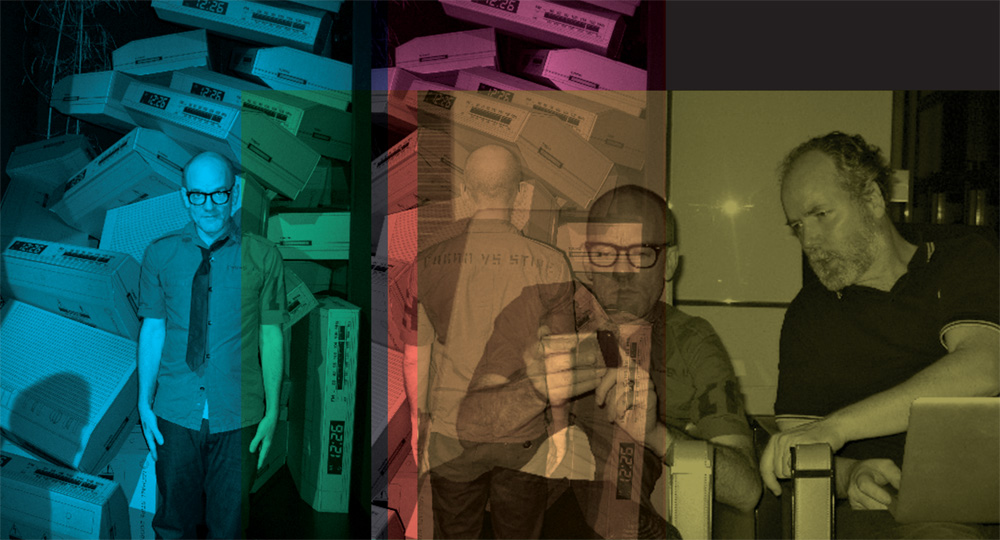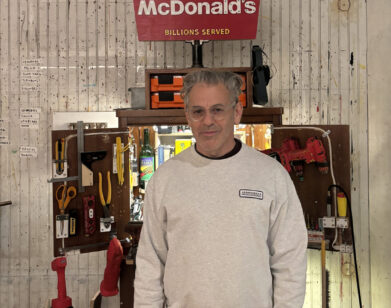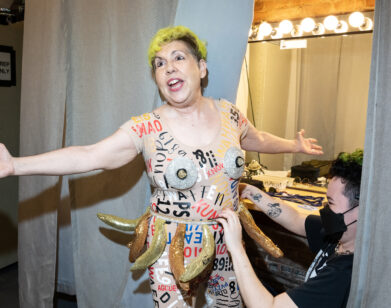Michael Stipe and Douglas Coupland
One defined a generation in music, the other in literature, but the R.E.M. front man and the Vancouver-based novelist both have serious sidelines in visual art. The future of art may be in the download, but hey, a renaissance has to start somewhere.
Michael Stipe and Douglas Coupland met at the presidential inauguration for Bill Clinton in 1993, and they’ve been discussing culture and ideas with each other ever since. While the public is already quite familiar with these two gentlemen (Stipe for his music and Coupland for his writing), their involvement in the visual arts is still a little more underground. Both attended art school in the early ’80s—one admittedly for a more protracted period than the other—and while Coupland resumed making visual art in 2000 after a decade-long hiatus, Stipe began to show just recently (his first exhibition, which involved bronze casts of cameras and cardboard boxes meant to look like electronics, was staged last summer at the Rogan store on New York City’s Bowery). Their artistic practices can best be described as post-medium, which is another way of saying that they use whatever means it takes to get their ideas across, and they both draw heavily on their own experiences as seen through a Pop and post-Pop lens. Here Stipe and Coupland take some time out to discuss art in the age of the Internet download.
DOUGLAS COUPLAND: I think we both started art school in 1980, although at different places and for different lengths of time. I was at Emily Carr College of Art and Design in Vancouver for four years, and I loved it. I think you were at the University of Georgia for only 11 hours. Was it a good 11 hours? Seriously. I don’t think I’ve ever asked you that.
MICHAEL STIPE: The art building was closer to downtown Athens than the English lit building. I wanted to be near the cafés and places to meet people. That’s all I wanted—to meet people, hook up, get laid, talk a lot, and start a band. I never imagined I’d actually learn something there, much less apply what I learned in a productive way. There are apparently some paintings I did as assignments that a few professors hung onto.
DC: That sounds kind of illegal.
MS: The paintings must be wretched. I’m a terrible painter and drawer and cannot stand my own handwriting or speaking voice, as you know.
DC: I’m a pretty good drawer. I have trouble painting because you literally have to wait for the paint to dry. I’m disciplined but I’m not patient. Hey, you had your first show at the Rogan store in New York last summer. The central pieces were the really voluptuous bronze castings of Polaroid cameras from the 1970s. How did you settle on that as the subject to explore?
MS: I was inspired by y-o-u, actually. I tried to figure out what holds memory for me without delving into the nostalgic, which I despise. I guess those devices became a cataloging of memory, really loaded with meaning . . . like having a hot one-night stand but remembering the hotel room key shape and wallpaper instead of the carnal details. The cameras themselves, the answering machine, and the digital clock radio became the memory
receptacle—kind of markers for experiences past.
DC: I get verklempt if I see a vintage TI-30 or TI-54 calculator. But I don’t think I’d want to use one.
MS: A few weeks ago I was looking at my old answering machine. It’s a cheap machine, boring and now useless, yet it evokes so many resonant moments. I’ve attached genuine memory and meaning and moments to this device, this thing that was the messenger, not the message.
DC: For the show, you also had really crisp custom-made cardboard boxes shaped like electronic equipment. They were heaped in piles outside the gallery, and people could take one if they wanted, which is great. Yet inside the gallery, none of the pieces were for sale. What’s your philosophy on this?
MS: I just did what I wanted to do. I’d never had a sculpture show before and I didn’t really know what to do. Plus I had Rogan [Gregory] and Team Rogan in my corner. And I love working in bronze. It’s so different from singing.
DC: I certainly hope so. And you can’t download a bronze. Not yet. When was the last time you got arted-out? You know what I mean? Like, “If I see one more seductive, delicious canvas my brain is going to explode.” I got it on the Bowery this year. And London can be deadly that way.
MS: The Reina Sofía in Madrid had a new media exhibition last summer [“Máquinas & Almas. Digital Art and New Media”] that was so fucking powerful I couldn’t go up a flight of stairs to even glance at Guernica. I just wandered back to the
hotel in a very modern daze.
DC: I always know it’s over when I say to myself, “Right, where’s the gift shop?” I kind of wonder if creativity is all morphing into one big thing that’s not even art, but something universal and bigger. Maybe it’s because all the new image-making technology, and all these other new smart machines, are allowing people to do it all.
MS: Well, if that gives us Tauba Auerbach and Steven Shearer, then I am there.
DC: Steven’s work is so amazing.
MS: Right now with the Internet and art, it’s like the late 1960s when Mercury Records was signing every band that had one song. What song will be the big hit? But now instead of music it’s artists messing with Photoshop. Which digital experiment will be the big hit? The charm right now is in the search, figuring out who or what’s worthwhile, and what’s crap—it’s fun but it gets tired fast.
DC: Sometimes I go on a Web binge and check out 50 different websites and I get “Basel-Miami head,” without the fuss and muss of actually going there.
MS: I feel right now that in order to fully enjoy the brilliance of new technologies, you have to be fully grounded in the real world where it feels real and dirty and raw and unplanned. Give me Berlin and Madrid—and even New York. Then, and only then, can you catalog your real-world experience and throw it up on your blog or whatever. Tell the truth and keep your links real. Links have become the suburbs of the real world.
DC: Sometimes I wonder if the world is too interesting and too boring at the same time. But you never get bored, do you?
MS: I’m never bored. Okay, once in Buenos Aires, and once in Houston. Doug, how come you don’t have a New York art dealer? Can we change that, like, now?
DC: Please, let’s. One weird worry at the moment is that Cathay Pacific Airways is going to reschedule their Flight 888 and turn it into a red-eye. It’s their Hong Kong–NYC run that stops in Vancouver. It’s the most convenient flight ever invented. It leaves in the early afternoon, and the return flight leaves in the evening. It’s like having a private jet to New York. Hey, have you ever bought art online? I bought some photos by Denis Darzacq. They really sing.
MS: No, I never have . . . oh wait, once I did buy an Antony Micallef painting, sight unseen except for the JPEG, because I loved one by him my friend Jamie [Catto] had. Jamie’s aunt sold it to me, and it became worth, like, $60 billion.
DC: It’s sort of a law of the art world: The stuff that grows in importance is only the stuff you bought because it wowed you.
MS: Those Darzacqs you mentioned earlier, I may have to follow suit and get some. They’re amazing.
DC: Do you buy anything else online?
MS: Vitamins, coffee cups, and, um, Spanish art porn.
DC: Olé.







